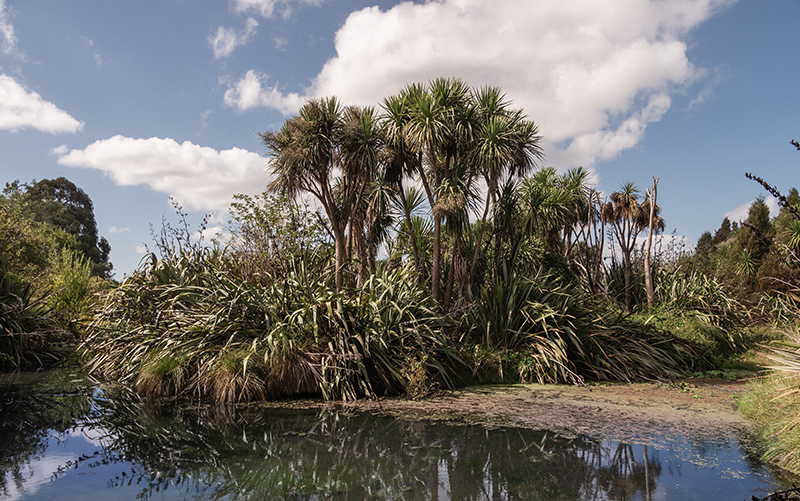What sustainability looks like to a winemaker with Esme Holdsworth from Grove Mill

Sustainability is a big buzzword in wine at the moment but it takes more than just a well managed vineyard for a winery to stand out as green in 2020. With solar panels, new eco-friendly packaging, and an ongoing programme to nurture the neighbouring wetlands, Grove Mill certainly makes the grade. We asked winemaker Esme Holdsworth why it makes a difference.
This article was created in partnership with Grove Mill.
Ask Esme Holdsworth what she loves most about winemaking and she’ll say the blend of science and art. Her original field of study was after all, pharmacology. But on completing her BSc, she decided research wasn’t for her. Acting on a family member’s suggestion, she headed to Lincoln University to study winemaking. Pharmacology’s loss was Grove Mill’s gain. When a chance came to work at the Marlborough winery, Esme leapt at it.
“I love how expressive the wines from the Wairau Valley are, and there is a fantastic team here at Grove Mill. And it’s great working at a winery that has such a strong sustainability ethos.”
To reflect that ethos Grove Mill has just revealed a stylish new look. Their bottles are made from recycled New Zealand glass, and the locally made bottle cap features images of the critters that live in the wetland next to the winery. The label is made from sugarcane, a highly renewable by-product of the sugar industry. “We wanted to make sure the bottle was as beautiful and thoughtful on the outside as the quality of the wine on the inside,” says Esme.

Testament to that quality is the multiple awards the wines have garnered over the years: this year their Grove Mill Sauvignon Blanc has already won gold at the New Zealand International Wine Show and the Marlborough Wine Show.
Here Esme tells dish the highlights of her job, why sustainability is important to Grove Mill, and which of the critters on the cap is her favourite.
dish: What do you love most about winemaking?
Esme: I love the combination of science and art. I also love that it’s such a team environment; every part of the business – from vineyard to logistics - is essential to making great wine that people love to drink. The industry as a whole is also very collaborative; people are always ready to share their knowledge and help each other out.
What inspires Grove Mill’s commitment to sustainability?
Sustainability has always been a part of the Grove Mill DNA. Soon after the winery was built, a wetland was established close by to nurture and protect native plants. Grove Mill continues to uphold the founding ethos of sustainability by continuing its habitat restoration programme. We’ve introduced 300 solar panels at the winery and we use New Zealand suppliers whenever possible. We’re always looking for ways we can improve – we’re making sure the legacy we’ve built over 30 years is enduring.
Where did the idea for the sugarcane label come from?
We believe in building sustainability into every aspect of wines, so it’s important to carry that through to our packaging. Sugarcane is one of the most sustainable materials available because it’s the by-product of an existing process – it’s a great material that would otherwise go to waste. As well as the labels, the recycled New Zealand glass bottles reduces our carbon footprint and supports our local glass industry.
Which of the critters featured on the bottle is your favourite?
The Southern Bell Frog. Not only is it our mascot, but the presence of frogs show us the environment in the wetland is healthy. They also have a tendency to come and check up on us in the winery, which always provides some fun in the workday as we return them to the wetland.

The Southern Bell Frog
When were the wetlands established and who by?
They were established in the early 90s not long after the winery was built. A group of Marlborough winegrowers got together to found Grove Mill and the wetlands. It’s so satisfying to see the impact they’ve had on the local eco-system 30 years later, and it’s great to think that what we’re doing now will have an impact in 30 years’ time.
Does Grove Mill aid or work on the wetlands?
Yes, we have an ongoing programme to nurture them. This includes continuing to plant native species while removing pest plants and animals to create a great habitat for species that support a healthy ecosystem. We consult with the team at FutureEcology to track biodiversity and ensure we are always going in the right direction for the health of our wetland. The team planted 700 native species on our last planting day – it was a well-deserved bottle of sauvignon blanc when we were finished!

Is there anything both the winery and the wetlands thrive on?
Water! We are very lucky with the quality of the water in Marlborough and both the wetland and winery rely on this. Marlborough is also a great climate in terms of sunshine hours and warmth for growing native plants and grape vines.
What makes a ‘good year’ in winemaking for you?
Weather. The most important part of a good year and producing a good wine is the quality of the grapes. We need adequate sunshine, heat and rain at the right times of the year. If all these pieces fall into place it results in healthy grapes which are full of flavour, then the wine really makes itself. When the last truck of grapes comes into the winery the viticulture team always reminds us not to mess up their hard work!
 Bottle cap and label were designed by Hannah Gordon
Bottle cap and label were designed by Hannah Gordon
The Grove Mill range includes Sauvignon Blanc, Chardonnay, Pinot Gris, Rosé and Pinot Noir and is available from Countdown and Liquorland.
Grove Mill
grovemill.co.nz
latest issue:
Issue #116
Issue 116 of dish is a special 20th birthday collector’s edition! This gorgeous issue brings the party to you, featuring delectable birthday cakes with recipes supplied by guest chefs – from Al Brown’s simply delicious Chocolate Fondant Cake to Ben Bayly’s Opera Celebration Cake. From cakes to sensational drinks and nibbles, to a French bistro feast and Sarah and Claire’s top 20 winter recipes, the magazine is jam-packed with dishes to make at home. 20 years strong and ready to party – issue 116 is on sale NOW!

